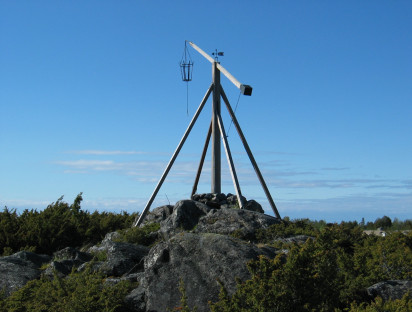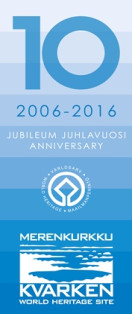The Molpehällorna island is a blend of geology, nature and history
When you want to experience the geology, the nature and the history of the Kvarken archipelago at the same time, the place to visit is the Molpehällorna island in Korsnäs. Molpehällorna is a group of four islets that have been united into one island, demonstrating the land uplift process in a concrete way.

A “vippbåk”, a reconstruction of the original beacon with a rocker arm has been built at the same location.
When you want to experience the geology, the nature and the history of the Kvarken archipelago at the same time, the place to visit is the Molpehällorna island in Korsnäs. Molpehällorna is a group of four islets that have been united into one island, demonstrating the land uplift process in a concrete way.
An object that reminds us of the history of the place is the “vippbåk”, a reconstruction of the original beacon with a rocker arm that had existed on the island. A fire was lit in the basket and lifted high up to guide the seafarers. According to sources, the original “vippbåk” was built in 1668.
Visit on your own or with a group
You can explore the nature of the archipelago on your own for example by taking a walk on the nature trail. After the walk it is a good idea to enjoy a picnic lunch and let your eyes rest on the scenery. For groups, there are guided tours on demand. The best time for visiting the island is in the summer, and there is an excellent place for boats to land. In the wintertime you can reach the island by skiing on the ice, some 8 kilometers from the continent.
During the application process for the World Heritage status, the area was visited by Jim Thorsell from Canada who was a representative for Unesco. It was the last evaluation visit before the decision on whether to accept the Kvarken Archipelago on the list of World Heritage Sites would be taken. Thorsell asked the chairman of Korsnäs municipality council of that time, Ann-Sofi Backgren, how local people would view the World Heritage Site.
“I answered that I believe and hope that the locals will become proud World Heritage ambassadors,” Backgren remembers.
The last lighthouse keeper saved his loved one from Russian soldiers
Backgren has since then participated in developing tourism in the World Heritage Site for example by planning a tourism package in this unique destination. The history of the Molpehällorna island has fascinated Backgren and especially the story of its last lighthouse keeper, Jakob Rautio.
The life of Jakob Rautio was filled with high speed and dangerous moments. He fell in love with a woman named Katri who was taken away by Russian soldiers. Jakob managed to save his loved one who nevertheless died after giving birth to a baby girl, Selmi. In 1790 Jakob moved to these islands in Molpe to become a lighthouse keeper, together with Selmi. He died in 1808 when the same Russian soldiers from whom he had saved Katri came to the islands due to the outbreak of the Finnish War.
The book Fyrvaktaren på Moikepää is from 1891. It tells the life story of Jakob Rautio, the last lighthouse keeper on the Molpehällorna island.
The story of Jakob Rautio is recounted in Fyrvaktaren på Moikepää (The Lighthouse Keeper of Moikipää) by Jon Olof Åberg in 1883, of which there was a copy of a copy in the Korsnäs library. Backgren later found a third edition of the book, published in 1891, in a storage library in Kuopio.
”The book Fyrvaktaren på Moikepää was most recently borrowed from the city library of Pori in 1925. It is unbelievable that despite that, it had been preserved for 80 years.”
On 12 August 2016, Backgren published a book with the title Jakob Rautio – den siste Fyrvaktaren på Moikepää fyr. Berättelser från världsarvet Kvarkens skärgård (Jakob Rautio – the last lighthouse keeper of the Moikipää beacon. Stories from the Kvarken Archipelago World Heritage) in which she retells Rautio’s story.
”This book is my way of preserving the cultural heritage. I am proud of our World Heritage Site. Our stones are unique in the world.”
Ann-Sofi Backgren is proud of the World Heritage Site and its unique stones.
Text: VASEK
Photographs: VASEK ja Ann-Sofi Backgren

The Kvarken archipelago is the only World Natural Heritage Site in Finland listed in the UNESCO World Heritage List. The archipelago is rising from the sea in a process of glacio-isostatic uplift in which the land that used to be weighed down by the glacier during the last Ice Age continues to lift today. Nowhere in the world is this uplift better displayed than in the Kvarken, and at rates that are among the highest in the world. Consequently, you can see unique glacial formations in the Kvarken archipelago, such as De Geer moraines and ribbed moraines, which make the scenery so exceptional and varied.
For more information go to http://www.kvarkenworldheritage.fi/experience-kvarken/
Read the other articles about the Kvarken archipelago:
Cruise to the Mickelsörarna, Granösund Museum, Sommaröhallen crafts shop, Aava Kerttu homestead, Merenkurkun Majatalo inn, Kvarkenturer & Villa Meribjörkö.